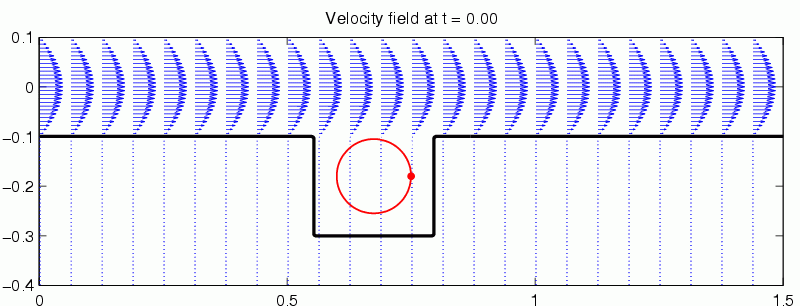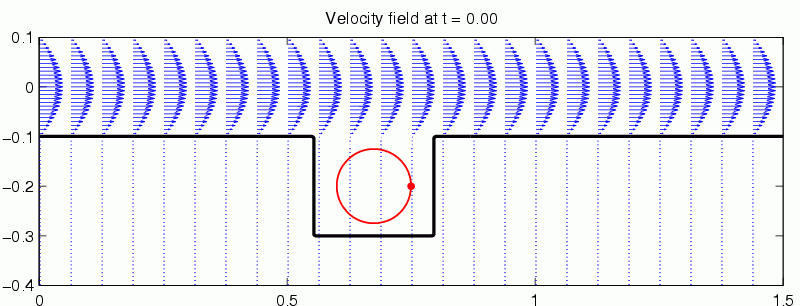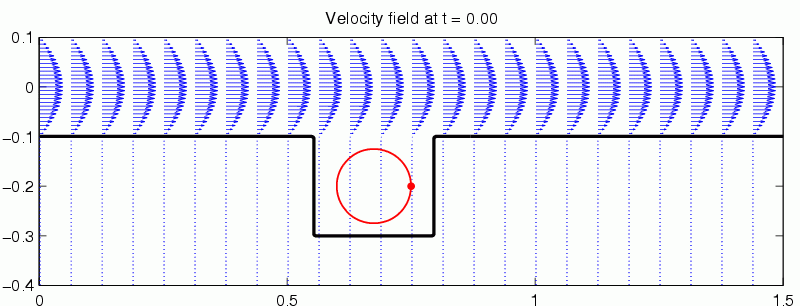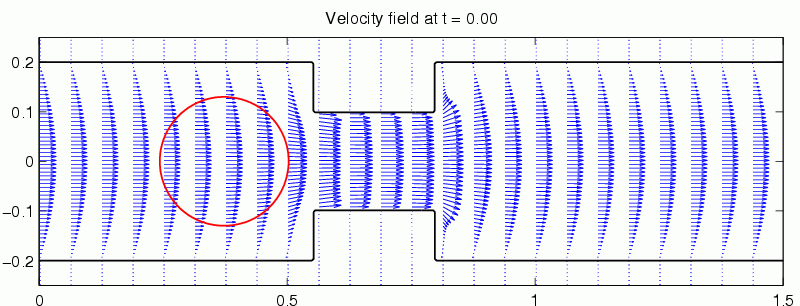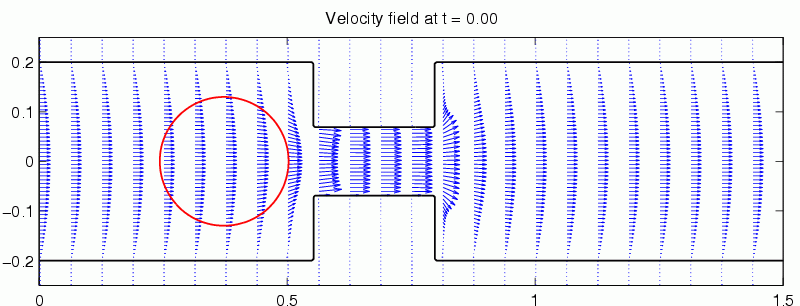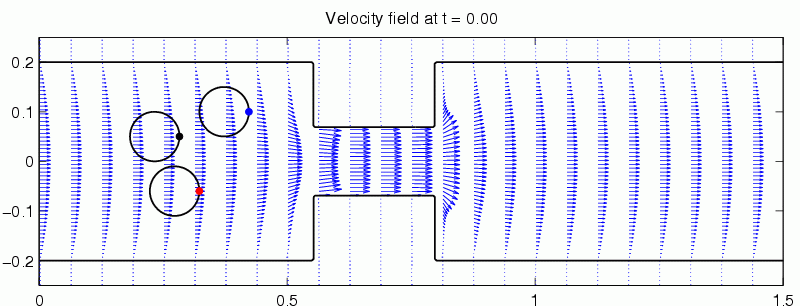-
Immersed Interface Methods for Incompressible Flows
Students: D.V. Le
Faculty: J. Peraire
Collaborators: B.C. Khoo (National University, Singapore)
We employ an immersed interface method (IIM) for solving low-to-moderate Reynolds number laminar incompressible flows involving moving interfaces and rigid boundaries. One of the challenges of these problems is that the fluid motion, the flexible interface motion and the interaction with the immersed rigid boundaries must be computed simultaneously. This is necessary to account for the complex interaction between the fluid and the immersed boundaries. An example of interface problems that we consider is shown in Fig. 1.
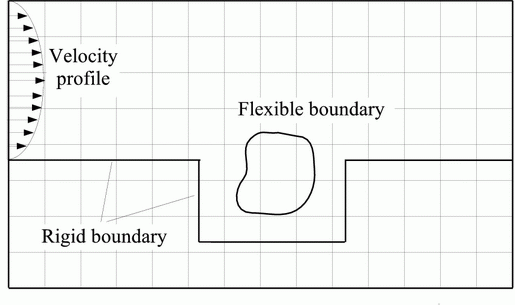
Figure 1. A typical domain in which the Navier-Stokes equations are solved.
In the immersed interface method, the flow is assumed to exist everywhere in the domain. The effect of the immersed boundaries on the fluid is accounted for through a singular force F which acts along the interface. The presence of this force results in solutions to the Navier-Stokes equations, which may be non-smooth across the interface, i.e., there may be jumps in pressure and in the derivatives of both pressure and velocity at the interface. An essential ingredient of the immersed interface method is the relation between the jumps in the solutions and their derivatives, and the applied singular forces. The basic idea of the immersed interface method is to discretize the Navier-Stokes equations on a uniform Cartesian grid and to account for the singular forces by explicitly incorporating the jumps in the solutions and their derivatives into the difference equations. The main advantage of the IIM is that the solutions of the Navier-Stokes equations on a uniform mesh can be done very efficiently with the use of fast solvers, and at the same time, complex geometrical changes can be handled in a rather seamless manner. The drawback of this method is that a special discretization of the Navier-Stokes equations near the immersed boundaries needs to be performed to maintain both accuracy and stability. In our algorithm, the immersed boundaries are represented by a number of Lagrangian control points. In order to guarantee that the no-slip condition on the rigid boundary is satisfied, singular forces are applied on the fluid. The force strength at the rigid boundary is determined by solving a small system of equations at each time step. For flexible boundaries, the forces that the boundary exerts on the fluid are computed from the constitutive relation of the flexible boundary and are applied to the fluid through the jump conditions. The position of the flexible boundary is updated implicitly using a quasi-Newton method (BFGS) within each timestep. The Navier-Stokes equations are discretized on a staggered Cartesian grid by a second order accurate projection method for pressure and velocity.
Our contributions include the introduction of a novel numerical algorithm for solving the incompressible Navier-Stokes equations in the presence of rigid boundaries. In our approach, both flexible and rigid boundaries can be considered simultaneously. We recall that most of the current methods can only handle flexible boundaries and the rigid boundary is required to be aligned with the computational grid.
Selected Publications and Presentations:
- D.V. Le, B.C. Khoo and J. Peraire. An immersed interface method for the incompressible Navier-Stokes equations. Presented at the SMA Symposium, Singapore 2004
- D.V. Le, B.C. Khoo and J. Peraire. An immersed interface method for the incompressible Navier-Stokes equations in irregular domains. In K.J. Bathe, Proceedings of the Third M.I.T. Conference on Computational Fluid and Solid Mechanics, pages 710-716, Elsevier Science, June 2005.
- Ph.D thesis: An Immersed Interface Method for Solving Viscous Incompressible Flows Involving Rigid and Flexible Boundaries (Thesis advisors: Prof. Jaime Peraire, Prof. Khoo Boo Cheong)
- PhD Oral presentation--(zip file: 7,225KB)
- Presentation at the Third M.I.T. Conference on Computational Fluid and Solid Mechanics--(zip file: 3,720KB)
- D.V.LE, B.C.KHOO, and J.PERAIRE, 'An immersed interface method for viscous incompressible flows involving rigid and flexible boundaries', Journal of Computational Physics,220, 109-138, 2006.
- D.V.LE, C.ROSALES, B.C.KHOO, and J.PERAIRE, 'A coupled IIM-BEM numerical method for the optimization of single-cell traps', submitted to the Journal of Computational Physics, 2006.
Animations:
- Grooved channel flow with an immersed weightless elastic membrane
Membrane is released at a height of -0.18 inside the groove for a unit Re = 50 (flow rate of 0.16)
Membrane is released at a height of -0.2 inside the groove for a unit Re = 50 (flow rate of 0.16)
Membrane is released at a height of -0.2 inside the groove for a unit Re = 250 (flow rate of 0.8)
Flow in a constriction with immersed elastic membranes
Membrane squeezing through a large constrictionMembrane squeezing through a small constriction
Three membranes going through a small constriction
Rigid particles in a fluid under the action of gravity
 |
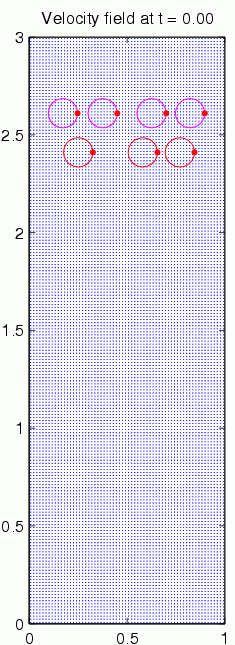 |


